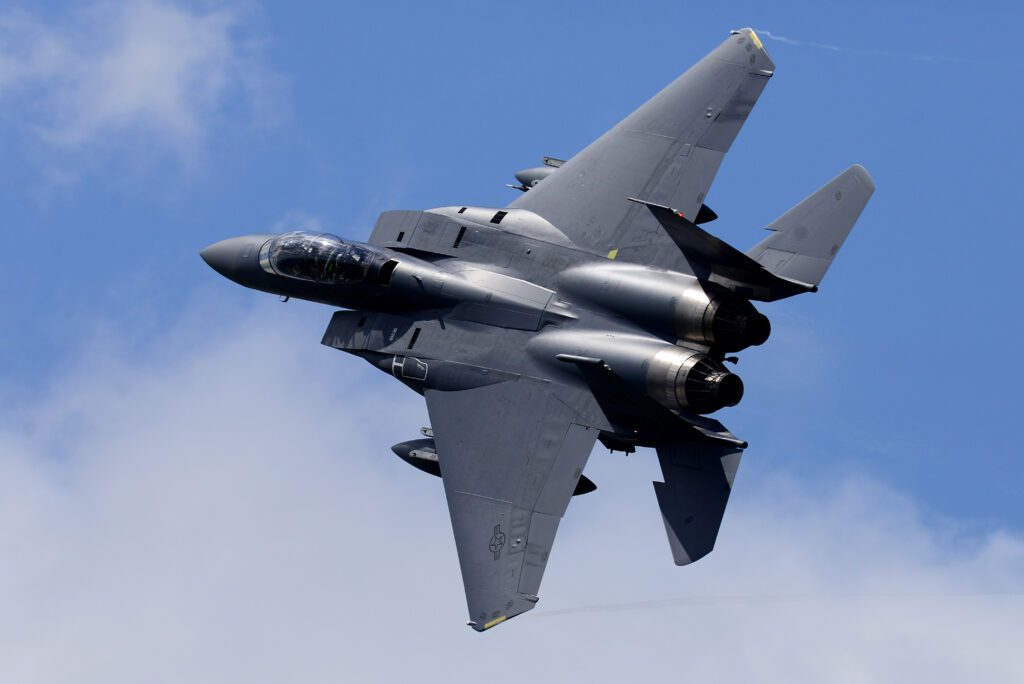
An F-15E Strike Eagle assigned to the 492nd Fighter Squadron flies over Royal Air Force Lakenheath, England. (U.S. Air Force photo / Tech. Sgt. Matthew Plew)
House and Senate appropriators in their committee-approved versions of the fiscal 2023 defense appropriations bill provide more than $194 million for upgrades to Boeing [BA] F-15 aircraft.
Lawmakers have yet to take up and pass the bills in their respective bodies after which House-Senate conferees are to negotiate on a final bill. The federal government is operating under a continuing resolution (CR) through Dec. 16. Congress passed the CR in September (Defense Daily, Sept. 30).
The F-15 upgrades include nearly $37 million for the Honeywell [HON] Advanced Display Core Processor II (ADCP II), integrated by Boeing on the F-15E and F-15EX, and more than $28 million for the Multifunctional Information Distribution System-Joint Tactical Radio System (MIDS-JTRS), a new Link 16 system to comply with the National Security Agency (NSA) cryptographic modernization mandate that military aircraft were to meet by Jan. 1 this year and a Federal Aviation Administration frequency remapping deadline of 2025.
Data Link Solutions (DLS)–a Collins Aerospace [RTX]/BAE Systems joint venture–and Viasat Inc. [VSAT] have built the software-defined MIDS-JTRS, which is to replace older radios with the NSA certified encryption and which is to feature a modular design to replace older MIDS-Low Volume Terminals (MIDS-LVTs).
As of Jan. 1 this year, eight F-15Cs and 52 F-15Es met the NSA mandate, and by March 16 another two F-15Cs and 10 F-15Es had received MIDS-JTRS, the U.S. Air Force has said.
In April, Rep. James Langevin (D-R.I.) told Air Force Secretary Frank Kendall that he was alarmed by the delay in the Air Force’s Link 16 crypto modernization effort, and Kendall said that the Air Force had recently begun devoting funding to the new radios after two decades of not upgrading radios because the U.S. had not postured its defense budget to take on high tech adversaries, like China (Defense Daily, Apr. 27).
In fiscal 2022, the Air Force requested more than $234 million for F-15 upgrades, but congressional appropriators provided about $179 million–a $55 million cut. Lawmakers said that $28 million of the decrease was due to ADCP II contract delays, $15 million to the F-15E digital color displays being “ahead of need,” $10 million to an ADCP depot hazardous air pollutants analysis being “ahead of need,” and about $1.9 million to F-15E MIDS-JTRS installs “excess to need.”
The Air Force approved ADCP II for full-rate production in the second quarter of fiscal 2021 and awarded Boeing a full-rate production contract of more than $59 million on Apr. 1 this year. Boeing referred questions on the one-year ADCP II contract delay to the Air Force Life Cycle Management Center (AFLCMC) at Wright-Patterson AFB, Ohio. Defense Daily will add any response received from AFLCMC.
The Air Force has said that the common mission computers for the F-15C and F-15E have hit their limits in speed, memory, throughput, and security. ADCP II, which is the F-15EX’s mission computer, is able to process 87 billion instructions per second of computing throughput, Boeing has said.
ADCP II had its first test flight on an F-15E from Eglin AFB, Fla. in July 2016.
The Air Force said that ADCP II is also to support the Boeing/BAE Systems’ Eagle Passive/Active Warning and Survivability System (EPAWSS) for the F-15 and to provide the F-15E’s Raytheon Technologies‘ [RTX] APG-82 radar with increased target tracks and track data and mode simultaneity. The F-15’s Tactical Electronic Warfare System (TEWS) is “functionally obsolete,” as it “uses 1970’s analog technology to combat 1980s-era radar-based ground and air threats,” while the digital EPAWSS electronic warfare system is “capable of detecting, identifying, locating, denying, degrading, disrupting, and defeating modern and emerging threat systems in contested airspace with dense radio-frequency (RF) background environments,” the Air Force has said.
Boeing has said that the Air Force plans to equip 43 of the service’s F-15Es with EPAWSS. That number would seem to indicate a ratcheting back of Air Force plans for F-15E EPAWSS upgrades, as the Air Force had projected last year that it would outfit all 217 service F-15Es with EPAWSS. The Strike Eagles have an average age of more than 29 years.
Some lawmakers have criticized the Air Force’s plan to divest its F-15C and D fleets by 2026 and to trim the service’s F-15EX buy from 144 to 80 (Defense Daily, Apr. 27).
In fiscal 2020, the Air Force said that many F-15Cs and Ds “are beyond their service life and have SERIOUS structures risks, wire chafing issues, and obsolete parts” and that “readiness goals [for the aircraft] are unachievable due to continuous structural inspections, time consuming repairs, and on-going modernization efforts.”
“The average F-15C/D is 35 years old with over 8,300 flight hours; the oldest F-15C was delivered in 1979,” the Air Force said then.
The fiscal 2022 National Defense Authorization Act allowed the Air Force to retire 48 F-15C/Ds and 47 Lockheed Martin [LMT] F-16C/Ds. The approved F-15C/D and F-16C/D retirements in fiscal 2022 were to bring the fighter inventory down from 2,094 to 1,999–just above the level required for an Air Force justification of planned fighter reductions.
The fiscal 2023 Air Force budget did not contain any proposed F-15C/D or F-16C/D divestments, but the service asked Congress to allow the service to retire 150 other aircraft.
This article was first published by Defense Daily, a sister publication to Avionics International; it has been edited. View the original version here >>